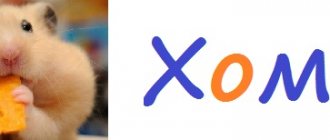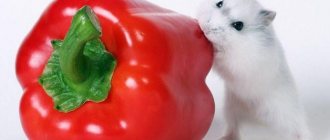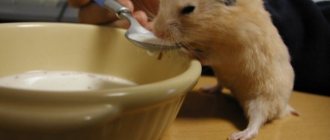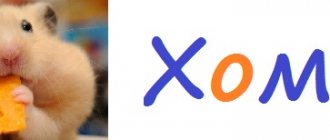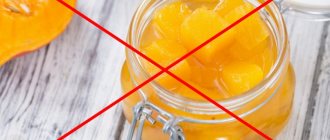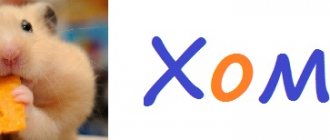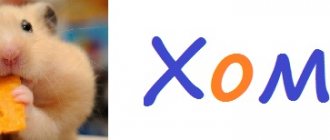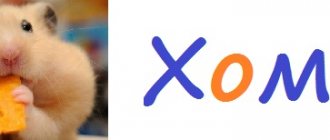Under natural conditions, rodents usually eat insects (grasshoppers, beetles, butterflies, etc.), as well as worms and larvae. To make up for the lack of protein food, it is recommended for pets to buy specialized food - bloodworms, mealworms, gammarus.
Some pet hamsters are reluctant to eat such complementary foods, and the owners try to supplement the pet's diet with products from their table. To understand whether you can give your hamster cheese, let’s look at the composition of the product in detail.
Harmful and beneficial components
The main ingredient for making cheese is milk. Sourdough and rennet (a substance obtained from the stomachs of calves), as well as many auxiliary components, are also used:
- salt;
- β-carotene;
- calcium chloride;
- potassium nitrate;
- annatto extract;
- calcium nitrate or sodium.
All these substances are allowed for the preparation of cheese by GOST. However, recently the quality of cheeses has decreased significantly, and it is difficult to find a product that meets these strict requirements.
The composition of ordinary cheeses lying on store shelves includes various additives, the harm of which is obvious even to people. And the delicate body of a small rodent will definitely react to them with indigestion or allergies.
If you manage to find a high-quality product with a good composition, you can offer your hamster low-fat cheese. A small portion will do him good.
When hamsters eat cheese, their bodies receive:
- Protein. Provides energy and is a building material for the cells that make up the body.
- Amino acids. Essential organic compounds that help fight infections and produce enzymes involved in metabolic processes.
- Vitamins. This dairy product is rich in vitamins of groups A, B, D. Helps strengthen the immune system and the entire body, prevent diseases of the cardiovascular system and visual organs.
- Microelements: potassium, calcium, as well as magnesium and phosphorus. Obtaining these substances is important for the prevention of cancer, maintaining the body during heavy physical activity, and normal functioning of the nervous system.
If your hamster eats cheese with pleasure, you need to choose the most healthy type of treat for him.
Porridge with milk
Many people are interested in whether it is possible to feed a hamster milk porridge. Under no circumstances should this be done. Not only does the porridge contain large quantities of milk, which is harmful to the hamster, but the cereal in it is boiled. Rodents are rodents because they should eat only raw cereals, vegetables and fruits. Their digestion is not suitable for digesting boiled, fried, baked and stewed food. If you want your hamster to live a long time and be healthy throughout its life, then you cannot feed it cereals with milk or water!
What kind of cheese should you not feed?
Some varieties are distinguished by high fat content, high content of salt, seasonings, and flavorings. Such food is contraindicated for animals. It will cause disturbances in the functioning of the heart, kidneys, and gastrointestinal tract, and will negatively affect the general condition.
Fused varieties
To get delicious processed cheese, manufacturers add milk powder, cream, and butter to the base - hard cheese. The fat content of the product increases significantly. Unscrupulous manufacturers use cheap vegetable substitutes (palm oil, etc.) instead of natural animal fats. In order to enhance the natural taste of the product and improve its appearance, salt, artificial flavors, thickeners, melting agents and other chemical additives are also added to it.
Sausage cheese is a type of processed cheese. Made from low-fat varieties of hard cheese. It also has a very bright taste, achieved through non-natural ingredients.
Sweet processed varieties contain no less harmful ingredients: sugar or artificial sweeteners, cocoa, syrups, coffee.
All these types of cheese are contraindicated for small pets.
"Blue cheese
You should also not feed your hamster blue cheese. Even people are not recommended to eat more than 50 grams of this delicacy per day. If the mold contained in the product is consumed excessively, the animal’s digestive tract will be damaged, flatulence and dysbacteriosis will develop. All these phenomena pose a danger to small rodents, so you should not risk your pet’s health.
Milk
Milk is the first food of every mammal's baby. It contains all the necessary components for the child to grow and develop properly. Hamsters also drink their mother's milk from birth until they switch to feeding on their own and there is no need for mother's milk. Under natural conditions, a rodent consumes milk only from its mother, while adults do not consume it and remarkably replenish the need for fluid in the body with ordinary water.
Can hamsters have milk? Since this is an unnatural product for an adult animal, it is not worth offering it.
You can give milk to hamsters in several cases:
- The female who gave birth died, and her newborn babies are not able to feed on their own;
- A pregnant or lactating female is weakened and needs additional feeding;
- The hamster is weakened due to a serious illness and can only eat liquid food.
What kind of milk can be given to hamsters?
If you decide to offer your pet this product, then pay attention to the following points:
- Milk should be low-fat, it is best to use a product with a fat content of no more than 1.5% fat;
- Choose cow's milk over goat's milk, as goat's milk is much fattier;
- Be sure to boil the milk and cool before feeding;
- Use dissolved milk powder, it is easier for rodents to digest;
- Before feeding milk for the first time, be sure to consult your veterinarian.
The best cheese for complementary feeding
Based on all of the above, you can decide whether a hamster can eat a particular type of cheese using the following indicators:
- Fat percentage. The lower it is, the better;
- The amount of salt in the composition. Also, less is more useful;
- Protein. Here it’s the other way around – a large percentage is welcome;
- Unnatural ingredients, palm oil, etc. Ideally, there should be none at all;
- Spices. It's better to do without them.
The listed properties are possessed by durum varieties with reduced fat content. This type of treat will be the safest addition to your pet’s diet. We also recommend that you familiarize yourself with the rules for feeding hamsters with dairy products.
What not to give to a hamster
Some foods that seem safe for your pet can actually be harmful to its health. These include:
- Food for parrots and other rodents
- Potato
- Acorns, chestnuts
- Persimmon
- Brazilian nut
There is nothing difficult about feeding a Syrian hamster. Remember that proper nutrition for an animal is the key to its long and healthy life. Inexperienced owners often wonder how many times a day they should feed their hamster. If everything is relatively clear with cats and dogs, then here we are talking about how to organize the nutrition of a rodent that is prone to making hiding places and supplies.
Healthy digestion is the basis of longevity for these animals, so attention should be paid not only to the composition of the diet, but also to the organization of the feeding regime. Hamsters are nocturnal and sleep almost all the time during the day.
This feature must be taken into account to decide how many times you can feed your hamster.
It's funny to watch the animal eat, but the optimal time is to feed once in the evening when the animal is active. Another acceptable option is feeding in the evening and early morning hours, before the animal naps during the day. The evening portion should be significantly larger than the morning portion.
Having decided on a schedule that is convenient for themselves, it is better for the owner to stick to one feeding time. With amazing accuracy, the animal will wait for dinner at the appointed time. This stability is beneficial for the rodent's digestion.
Due to the high metabolic rate, the hamster cannot tolerate hunger strike at all. It is difficult to answer unequivocally how many times a day a hamster should eat.
When it comes to how often you should feed your hamster, it is important not to overdo it. You cannot give food more than twice a day: this will disturb the animal’s sleep.
Juicy and can spoil if the hamster does not eat it right away. For the same reason, inventories are regularly inspected, removing spoiled products.
How to introduce it into the diet
How often can you give cheese to a hamster, in what portions and in general, when and how to start feeding this controversial product so that the baby only benefits from it, we will consider below.
Since protein food does not form the basis of the diet of wild rodents, there is no need to add it to the diet too often. Two or three times a week will be enough. Set aside special “protein” days (Monday and Friday or others, as convenient for you). This must be done so as not to get confused and not harm the pet with excessive amounts of treats. On one of these days, you can treat your furry friend to a piece of cheese.
The portion should be small - a crumb the size of a sunflower seed.
You should start feeding the animal a new product carefully - first give half the portion, then evaluate the reaction of the baby’s body. If all is well, you can continue introducing the product into your diet.
The age of the rodent that first tried this delicacy should not be less than 6 months.
Can hamsters eat grapes?
Hamsters can eat grapes, and they love this healthy fruit. Grapes are berries, but not citrus fruits, so they are completely safe for hamsters. However, if you are keeping diabetic dwarf hamsters, then this product is not suitable for regular feeding.
To make sure grapes are safe for hamsters, you can crush them and see if they have seeds, or, as a last resort, remove them yourself. Grape seeds can pose a choking hazard to hamsters and should always be removed first. And as previously mentioned, dwarf hamster species should not be fed large amounts of sugary foods, and grapes contain a lot of sugar.
What grapes do hamsters prefer? There is no evidence that hamsters prefer green or red grapes, so it comes down to personal preference. You can feed your hamster grapes every few days, and they certainly shouldn't be the main staple of his diet. Eating too many fruits and vegetables, which contain fiber, can cause stomach upset and diarrhea.
Also be careful - hamsters love to hoard and store food. So use fresh food sparingly and check every few days that your hamster has eaten all of his food.
Should I give it to dzhungarikas and Syrian hamsters?
The answer to the question whether high-fat cheese can be eaten for dzhungarikas is definitely negative. This breed is not very healthy; their body is extremely sensitive to low-quality food, so it’s not worth the risk. Cheese can harm Djungarian hamsters.
Another popular breed of hamster is the Syrian. Giving Syrian hamsters cheese is also not recommended. Salt and fats in the product will harm the health of the baby. Therefore, either choose hard varieties with low fat content and give them rarely and in small portions, or simply treat him to low-fat boiled chicken.
How much do pet hamsters eat?
Your pet is a nocturnal animal, you need to remember this. During the day he sleeps, and at night he eats, plays, exercises on a “simulator,” stores supplies, and sharpens his teeth. Therefore, the best option is to feed the baby twice a day. In the evening - the main meal, a hearty breakfast. In the morning, before bed, have a light dinner.
The amount of food that should be given to an animal at one time depends on the type and size of the rodent. When feeding twice a day, the Syrian is given one tablespoon of the feed mixture, and the Djungarian is given one teaspoon. Campbell's hamsters and other dwarf species feed similarly.
He will hide all the food that the hamster does not eat at one time in the pantry “for a rainy day.” Periodically review these supplies and remove perishable foods so that the animal does not get poisoned. Be sure to put something fresh in place of the “seized valuables”. Otherwise, the baby may become seriously stressed because all his reserves have disappeared, and he will die of hunger in the long, cold winter.
Prohibited Products
There is an opinion among inexperienced owners that hamsters of other breeds can eat this or that food, but not Syrian ones. In fact, this assumption is not true and the list of prohibited products applies to representatives of all varieties.
Hamsters are contraindicated to eat:
- chocolate;
- mushrooms;
- canned food;
- fruit seeds;
- milk;
- citrus;
- bakery products;
- pine needles;
- cabbage;
- sorrel, lingonberry, sea buckthorn and other plants with essential oils;
- feed for other animals and birds;
- fatty, salty, spicy and sweet foods.

